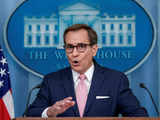Suggest a new Definition
Proposed definitions will be considered for inclusion in the Economictimes.com
Budget
- PREV DEFINITIONGross Budgetary SupportThe government’s support to the Central plan is called Gross Budgetary Support.Read More
- NEXT DEFINITIONHuman Development IndexThe Human Development Index (HDI) is a statistical tool used to measure a country's overall achievement in its social and economic dimensions.Read More
What is 'Gross Domestic Product'
Definition: GDP is the final value of the goods and services produced within the geographic boundaries of a country during a specified period of time, normally a year. GDP growth rate is an important indicator of the economic performance of a country.
Description: It can be measured by three methods, namely,
1. Output Method: This measures the monetary or market value of all the goods and services produced within the borders of the country. In order to avoid a distorted measure of GDP due to price level changes, GDP at constant prices o real GDP is computed. GDP (as per output method) = Real GDP (GDP at constant prices) – Taxes + Subsidies.
2. Expenditure Method: This measures the total expenditure incurred by all entities on goods and services within the domestic boundaries of a country. GDP (as per expenditure method) = C + I + G + (X-IM) C: Consumption expenditure, I: Investment expenditure, G: Government spending and (X-IM): Exports minus imports, that is, net exports.
3. Income Method: It measures the total income earned by the factors of production, that is, labour and capital within the domestic boundaries of a country. GDP (as per income method) = GDP at factor cost + Taxes – Subsidies.
In India, contributions to GDP are mainly divided into 3 broad sectors – agriculture and allied services, industry and service sector. In India, GDP is measured as market prices and the base year for computation is 2011-12. GDP at market prices = GDP at factor cost + Indirect Taxes – Subsidies
Also See: Gross Budgetary Support
Description: It can be measured by three methods, namely,
1. Output Method: This measures the monetary or market value of all the goods and services produced within the borders of the country. In order to avoid a distorted measure of GDP due to price level changes, GDP at constant prices o real GDP is computed. GDP (as per output method) = Real GDP (GDP at constant prices) – Taxes + Subsidies.
2. Expenditure Method: This measures the total expenditure incurred by all entities on goods and services within the domestic boundaries of a country. GDP (as per expenditure method) = C + I + G + (X-IM) C: Consumption expenditure, I: Investment expenditure, G: Government spending and (X-IM): Exports minus imports, that is, net exports.
3. Income Method: It measures the total income earned by the factors of production, that is, labour and capital within the domestic boundaries of a country. GDP (as per income method) = GDP at factor cost + Taxes – Subsidies.
In India, contributions to GDP are mainly divided into 3 broad sectors – agriculture and allied services, industry and service sector. In India, GDP is measured as market prices and the base year for computation is 2011-12. GDP at market prices = GDP at factor cost + Indirect Taxes – Subsidies
Also See: Gross Budgetary Support
- PREV DEFINITIONGross Budgetary SupportThe government’s support to the Central plan is called Gross Budgetary Support.Read More
- NEXT DEFINITIONHuman Development IndexThe Human Development Index (HDI) is a statistical tool used to measure a country's overall achievement in its social and economic dimensions.Read More
Related News
 How Modi govt can turn India into a real estate powerhouse in Union Budget, brick by brickIndia's ambitious goal to become a developed nation by 2047 relies heavily on a robust real estate sector. Contributing 7.3% to GDP, real estate drives job creation, supports allied industries, and boosts economic growth. Key policy measures in Union Budget 2024, such as tax rationalization and land utilization, are essential for sustained sectoral and national development.
How Modi govt can turn India into a real estate powerhouse in Union Budget, brick by brickIndia's ambitious goal to become a developed nation by 2047 relies heavily on a robust real estate sector. Contributing 7.3% to GDP, real estate drives job creation, supports allied industries, and boosts economic growth. Key policy measures in Union Budget 2024, such as tax rationalization and land utilization, are essential for sustained sectoral and national development. India has room to cut borrowings by Rs 50,000-75,000 cr in FY25 budget: Axis Bank treasurerUNION BUDGET EXPECTATIONS: India may reduce its current year's gross market borrowings in the final budget next week due to a higher-than-expected central bank surplus transfer and strong revenue collections. Axis Bank's treasury head, Neeraj Gambhir, suggests borrowing could decrease by 500-750 billion rupees ($6-9 billion), with a potential 20-basis-point reduction in the deficit target.
India has room to cut borrowings by Rs 50,000-75,000 cr in FY25 budget: Axis Bank treasurerUNION BUDGET EXPECTATIONS: India may reduce its current year's gross market borrowings in the final budget next week due to a higher-than-expected central bank surplus transfer and strong revenue collections. Axis Bank's treasury head, Neeraj Gambhir, suggests borrowing could decrease by 500-750 billion rupees ($6-9 billion), with a potential 20-basis-point reduction in the deficit target. Direct tax mopup 20% bigger in FY25 on income tax boostDirect tax collections have seen a significant increase of nearly 20% to ₹5.74 lakh crore in FY25 so far, with personal income tax flows driving the surge. The government may have more fiscal flexibility in the upcoming budget presentation. Corporate profits are also on the rise, reflected in the advance tax collections. These positive trends could impact the fiscal deficit in the budget for this fiscal year.
Direct tax mopup 20% bigger in FY25 on income tax boostDirect tax collections have seen a significant increase of nearly 20% to ₹5.74 lakh crore in FY25 so far, with personal income tax flows driving the surge. The government may have more fiscal flexibility in the upcoming budget presentation. Corporate profits are also on the rise, reflected in the advance tax collections. These positive trends could impact the fiscal deficit in the budget for this fiscal year. UK economy grew by more than expected in May, helped by house-buildingBritain's economic output increased by 0.4% in May, a higher than expected increase, largely due to a surge in housing construction. The Office for National Statistics data showed a broad-based increase in services, manufacturing, and construction industries, with the housing sector contributing to a 1.9% increase. The economy expanded by 0.9% over the three months to May, the strongest since January 2022.
UK economy grew by more than expected in May, helped by house-buildingBritain's economic output increased by 0.4% in May, a higher than expected increase, largely due to a surge in housing construction. The Office for National Statistics data showed a broad-based increase in services, manufacturing, and construction industries, with the housing sector contributing to a 1.9% increase. The economy expanded by 0.9% over the three months to May, the strongest since January 2022. India needs 1 million high-tech engineers as economy expandsIndia’s $250 billion tech sector plays an important role in the economy, employing about 5.4 million people. Tech services make up about 7.5% of the country’s $3 trillion-plus gross domestic product.
India needs 1 million high-tech engineers as economy expandsIndia’s $250 billion tech sector plays an important role in the economy, employing about 5.4 million people. Tech services make up about 7.5% of the country’s $3 trillion-plus gross domestic product. Official employment data masks India's jobs problem, say economistsIndia's employment growth mainly comes from self-employment, unpaid work, and temporary farm hires, which are not equivalent to formal jobs, economists said. Despite claims of 20 million new jobs annually since 2017/18, much of this increase is in agriculture and self-employment due to insufficient business demand.
Official employment data masks India's jobs problem, say economistsIndia's employment growth mainly comes from self-employment, unpaid work, and temporary farm hires, which are not equivalent to formal jobs, economists said. Despite claims of 20 million new jobs annually since 2017/18, much of this increase is in agriculture and self-employment due to insufficient business demand. US encouraging partnerships between NATO alliance and friendly nations in Indo-Pacific: White HouseBiden will welcome NATO leaders and the first lady and he will host a 75th anniversary commemoration event at the Mellon Auditorium on Tuesday. That is the site where the NATO treaty was formally signed in 1949.
US encouraging partnerships between NATO alliance and friendly nations in Indo-Pacific: White HouseBiden will welcome NATO leaders and the first lady and he will host a 75th anniversary commemoration event at the Mellon Auditorium on Tuesday. That is the site where the NATO treaty was formally signed in 1949. India will fail to plug jobs gap even with 7% growth, says CitiThe quality of jobs being created in India is another challenge, the economists said. An analysis of the official data showed about 46% of the workforce is still employed in agriculture, even though the sector contributes less than 20% to gross domestic product.
India will fail to plug jobs gap even with 7% growth, says CitiThe quality of jobs being created in India is another challenge, the economists said. An analysis of the official data showed about 46% of the workforce is still employed in agriculture, even though the sector contributes less than 20% to gross domestic product. UK economy grew 0.7% in first quarter of 2024Britain's economy grew by 0.7% in the first quarter of this year compared to the previous quarter, surpassing an initial estimate of 0.6% growth, according to official figures released on Friday. This data arrives just days before a national election where opinion polls suggest Labour Party leader Keir Starmer may replace Conservative Prime Minister Rishi Sunak.
UK economy grew 0.7% in first quarter of 2024Britain's economy grew by 0.7% in the first quarter of this year compared to the previous quarter, surpassing an initial estimate of 0.6% growth, according to official figures released on Friday. This data arrives just days before a national election where opinion polls suggest Labour Party leader Keir Starmer may replace Conservative Prime Minister Rishi Sunak. US weekly jobless claims drift lowerInitial claims for state unemployment benefits dropped 6,000 to a seasonally adjusted 233,000 for the week ended June 22, the Labor Department said on Thursday. The claims data included last Wednesday's Juneteenth National Independence Day, a new holiday. Claims tend to be volatile around public holidays.
US weekly jobless claims drift lowerInitial claims for state unemployment benefits dropped 6,000 to a seasonally adjusted 233,000 for the week ended June 22, the Labor Department said on Thursday. The claims data included last Wednesday's Juneteenth National Independence Day, a new holiday. Claims tend to be volatile around public holidays.
Load More